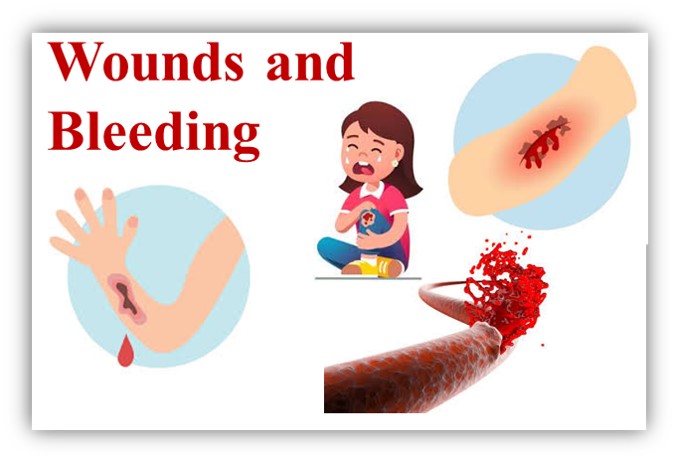Definition of wound
A wound is a break in the continuity of the tissue of the body either internal or external.
Common Causes of Wounds
Wounds usually result from external physical forces. The most common accidents resulting in open wounds are accidental falls and handling of sharp objects, tools, machinery and weapons.
Classification of Wounds
- Open wound: an open wound is a break in the skin or the mucus membrane.
- Closed wound: a closed wound involves injury to underlying tissues without a break in the skin or mucous membrane.
Types of Open Wounds
- Abrasions
- Incisions
- Lacerations
- Punctures
- Avulsions
Abrasions
- The outer layers of the protective skin are damaged. It usually results when the skin is scraped against a hard surface.
- Bleeding is limited.
- Danger of contamination and infection is high.
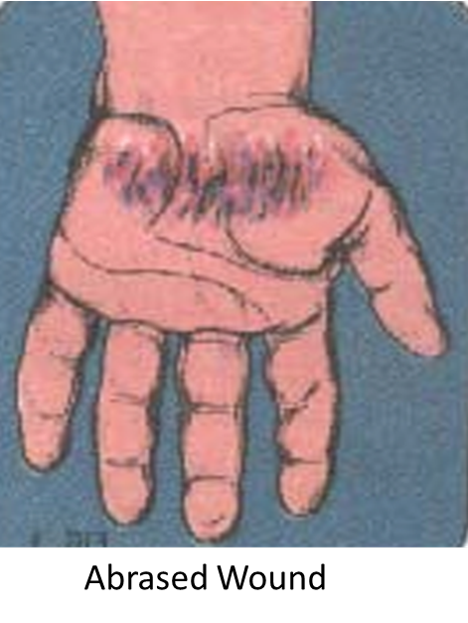
Incised Wounds
- It frequently occurs when body tissue is cut on knives, rough edges of metal, broken glass or other sharp objects.
- Bleeding may be rapid and heavy.
- Deep cuts may damage muscles, tendons and nerves.
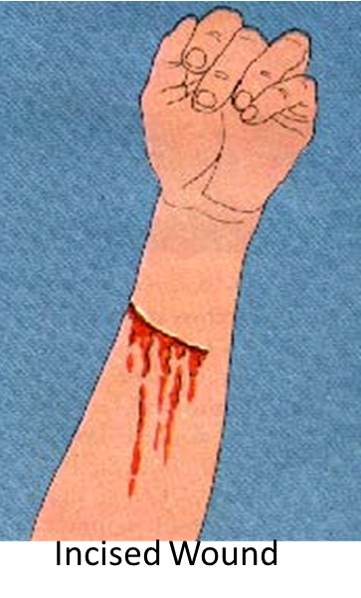
Lacerations
- It is jagged, irregular or blunt breaking or tearing of the soft tissues and is usually caused when great force is exerted against the body.
- Bleeding may be rapid and extensive.
- Destruction of tissue is greater in a lacerated wound than in a cut.
- Deep contamination of the wound increases the chance for later infection.
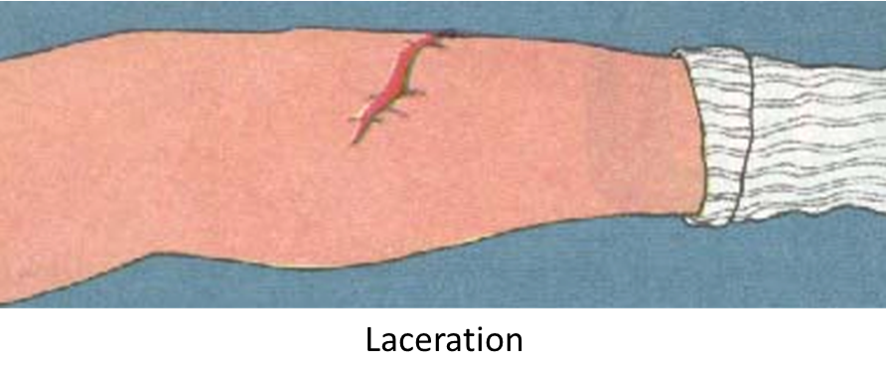
Puncture
- It is produced by an object piercing skin layers, creating a small hole in the tissue. It is produced by objects such as bullet and pointed objects like pins, nails and splinters.
- External bleeding is usually quite limited.
- Internal damage may have resulted to the organs causing internal bleeding.
- The hazard of infection is increased because of the limited flushing action of external bleeding.
- Tetanus may develop.
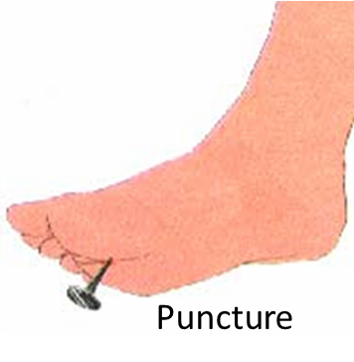
Avulsions
- It results when tissue is forcibly separated or torn off from the victim’s body.
- An incised wound, a lacerated wound, or both will usually occur when a body part is avulsed.
- There will be heavy and rapid bleeding.
- An avulsed body part may be reattached to a victim’s body by a surgeon. Send the body part along with victim to the hospital.
- Avulsed wound occurs in accidents such as motor vehicle, wrecks, gunshots, explosions, animal bites and other crushing injuries.
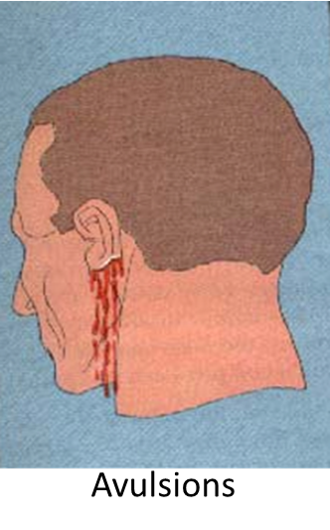
Bleeding: is loss of blood, usually through disease, injury, or other physical conditions.
Internal bleeding:
- Bleeding inside body cavity may follow an injury, such as a fracture or a penetrating wounds, but can also occur spontaneously for example, bleeding from a stomach ulcer.
- The main risk from internal bleeding is shock. In addition, blood can build up around organs such as the lungs or brain and exert damaging pressure on them.
- You should suspect internal bleeding if a casualty develops signs of shock without obvious blood loss. Check for any bleeding from body openings (orifices) such as the ear, mouth, urethra, or anus.
How to recognize internal bleeding
- Initially, pale, cold, clammy skin. If bleeding continues, skin mayturn blue- grey (cyanosis).
- Rapid, weak pulse
- Thirst
- Rapid , shallow breathing
- Confusion, restlessness, and irritability.
- Possible collapse and unconsciousness
- Bleeding from body openings (orifices)
- In case of violent injury, “pattern bruising” an area of discolored skin with a shape that matches the pattern of clothes, crushing objects, or restricting objects (such as seat belt).
- Pain
- Information from the causality that indicates recent injury or illness; previous similar episodes of internal bleeding; or use of drugs to control a medical condition such as thrombosis. (in which unwanted clots form in blood vessels).
| Site | Appearance of blood | Cause of blood lose |
| Mouth | Bright red, frothy, coughed – up blood | Bleeding in the lungs. |
| Vomited blood, red or dark reddish brown, resembling coffee grounds | Bleeding with in the digestive system. | |
| Ear | Fresh, bright red blood | Injury to the inner or outer |
| Thin, watery blood | Leakage of fluid from around brain due to head injury | |
| Nose | Fresh, bright red blood | Ruptured blood vessels in the nostril. |
| Thin watery blood | Leakage of fluid from around brain due to head injury | |
| Anus | Fresh, bright blood | Piles, Injury to the anus or lower intestine |
| Black, tarry, offensive- smelling stool (melaena) |
Disease or injury to the intestine | |
| Urethra | Urine with a red or smoky appearance and occasionally containing clots. | Bleeding from the bladder, kidney, or urethra. |
| Vagina | Either fresh or dark blood | Menstruation, Miscarriage, pregnancy or recent childbirth, Disease of, or injury to, the vagina or uterus |
First Aid for Severe Bleeding
Need for Immediate Action:-The reason why intervention of first aider needed is to stop any large rapid loss of blood and to treat for shock and prevent death.
Techniques to stop severe bleeding (described in order below)
Direct Pressure
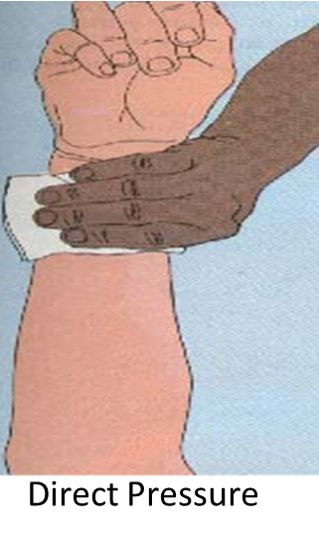
It is the preferred method for the control of severe bleeding since it prevents blood loss from the body without interference with normal blood circulation.
- Apply direct pressure by placing the palm of the hand over a thick pad directly on the entire area of an open wound; protecting the hand from contact to the blood in order to prevent HIV/ AIDS transmission.
- In case of very severe bleeding, manual pressure over the main artery, nearest to the bleeding point, should be applied as well as direct pressure over the wound itself.
- Apply the pressure bandage, maintain a steady pull on the bandage, and then tie the bandage with the knot directly over the pad.
Elevation
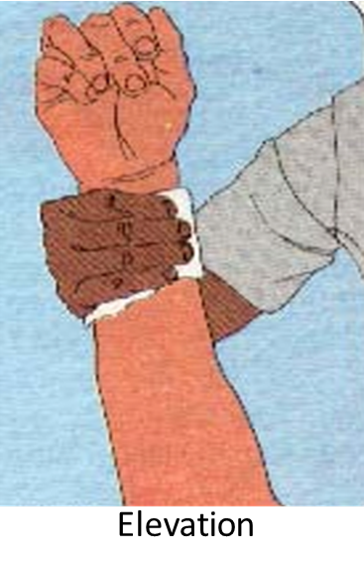
- Unless there is evidence of a fracture, a severely bleeding open wound of the hand, neck, arm or leg should be elevated above the level of the victim’s heart.
- Elevation uses the force of gravity to help reduce blood pressure in the injured area and slows down the loss of blood through the wound, however, it should be aided by direct pressure.
Pressure on the Supplying Artery
- If severe bleeding from an open wound of the arm or leg does not stop after the application of direct pressure plus elevation, the pressure point technique may be required.
- Use the pressure point technique by temporarily compressing the main artery (which supplies blood to the affected limb) against the underling bone and nearby tissues the technique also stops circulation within the limb.
- Use it for short duration of time.
- Use the brachial artery for the control of severe bleeding from an open arm wound (it is situated in the inside of the arm between the biceps and triceps about mid-way between the armpit and the elbow).

Tourniquet
The use of a tourniquet is dangerous, and the tourniquet should be used only for a severe life-threatening hemorrhage that cannot be controlled by other means.
Prevention of Contamination and Infection
Open wounds are subject to contamination and infection. This danger can be prevented or minimized by appropriate first aid measures, depending up on the severity of bleeding.
Safeguards
Whenever a dressing is applied to control bleeding, whether bleeding is severe or not, safeguards must be taken
- Do not remove or disturb the cloth pad initially placed on the wound.
- Do not try to cleanse the wound, since the victim requires medical care.
- Watch for signs of shock before and during transportation.
- Immobilize the injured area.
- Adjust the victim in a lying position so that the affected limb can be elevated.
Measures to be taken with wounds without severe bleeding
To cleanse a wound, wash your hands thoroughly with soap and water.
- Wash in and around the wound to remove bacteria and other foreign materials (wash the wound from inside to outer side).
- Rinse the wound thoroughly by flushing with clean water.
- Blot the wound, dry with a sterile gauze pad or clean cloth.
- Apply a dry bandage or clean dressing and secure it firmly in place.
- Inform the victim to see a physician immediately if evidence of infection appears..
Removal of foreign objects
- In small open wounds, some foreign materials often remain in the skin, tissues or underlying surfaces. Such objects irritate the victim, and unless they are removed they can cause infection.
- Use tweezers, sterilized over a flame or in boiling water, to pull out any foreign matter from the surface tissue.
- Lift out those objects embedded just beneath the skin with a tip of a sterilized needle (with alcohol or flame).
- Deeply embedded foreign objects in the tissues, regardless of size should be left for removal by health personnel.
- The fishhook is probably one of the most common types of foreign objects that may penetrate the skin. If the fishhook goes deeper and the barb becomes embedded, it is advisable to be removed by pushing it through until the barb protrudes. Cut the hook either at the barb or at the shank and remove it. Clean the wound thoroughly and cover it with an adhesive compress. Consult physician for possibility of infection, especially tetanus.
- Some penetrating foreign objects such as sticks or pieces of metal may protrude loosely from the body. Under no circumstance should the victim be pulled loose from the fixed object. If the object is fixed or protrudes more than a few inches from the body, it should be left in place, be cut off at a distance from the skin, and be secured from being damaged.
- Immobilize the protruding end with massive dressing around the protruding part, and then transport the victim to a hospital without delay.
Dressing the Wound
Dressing a wound helps to protect it from additional injury and contamination, and to assist in the control of bleeding.
Infection
If bacteria get inside tissues of the body through breaks in the skin or mucous membranes, serious infection may develop within hours or days following an injury. These will result in delay of wound healing. The first aider should recognize this fact and combat against development of infection, e.g. Tetanus.
Signs and Symptoms of Infection include the following:
- Swelling of the affected part
- Redness of the affected part.
- A sensation of heat
- Throbbing pain
- Fever
- Pus formation
- Swelling of lymph nodes depending on the affected sites.
- Red streaks leading from the wound (sign of spreading of infection through the lymphatic circulation).
Emergency Care for Infection
In case of delay of medical care, the first aider should do the following for infection.
- Keep the victim lying down and quiet and immobilize the entire infected area.
- Elevate the affected body part if possible.
- Apply heat to the area with hot water bottle or placing warm, moist towels or clothes over the wound.
- Do not delay efforts to get medical care for the victim.
Bites and stings
Injuries produced by animal or human bites may cause punctures, lacerations or avulsions. Not only care for open wounds but also consideration must be given to the danger of infection, especially rabies.
Human Bite
Human bites that break the skin may become seriously infected because many bacteria exist in the mouth. Cleanse the wound thoroughly with clean water, dry, cover it and seek medical attention.
Animal Bite
The bite of any animal or a pet may result in an open wound. Dog and cat bites are common. A rabbi is a viral infection which can be transmitted from infected animals such as dogs and cats to human being. There is no known cure for rabies in human beings or animals once symptoms develop.
- A bite on the face or neck should receive immediate medical attention, because of the proximity to brain.
- Keep the animal under observation, if possible, at least for 10 days.
- Do not kill the animal unless absolutely necessary. Injuries produced by animal or human bites may cause punctures.
- Tetanus is an added danger in an animal bite. Any animal bite carries a great risk of infection.
First Aid Measures
First aid measure for animal bite is similar to other types of wounds but in the case of dog bite:
- Wash the wound thoroughly with soap and water, flush the bitten area. Animal bit wounds are not recommended to be sutured and dressed.
- Make sure that the victim avoids movement of the affected part until he/she receives the medical attention.
- Refer the victim to health institution for medical attention.
Etiologic factor
Blunt
- Direct blow to skin (e.g., fist, rock, stick)
- Indirect blow to skin surface (e.g., blast wave from gunshot)
Penetrating
- Puncture or cutting of skin surface (e.g., knife, glass, nail, blade and needle)
Assessment Findings
- Contusion
- Laceration
- Avulsion
- Abrasion
- Bleeding
- Pain
- Neurovascular compromise
